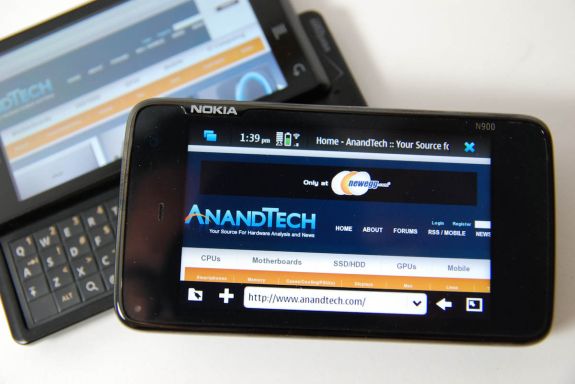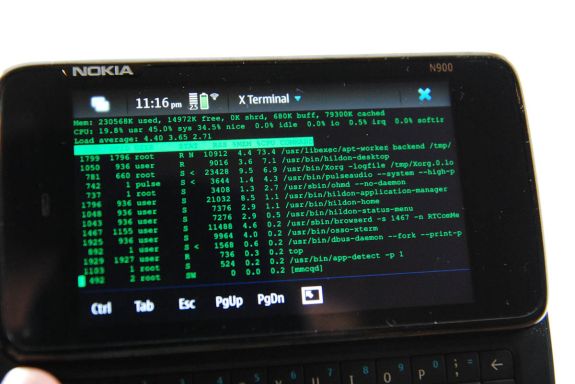Two OMAP 3430 Phones: Nokia N900 and Motorola Droid
by Brian Klug on June 10, 2010 9:29 PM EST- Posted in
- Smartphones
- N900
- Maemo
- Motorola Droid
- Droid
- MeeGo
- Android
- Mobile
Conclusions
We've revisited two phones running the same SoC, each a bit over halfway into their product life cycles. It's an interesting perspective that this gives us, as they're no longer the latest and greatest, but still far above average, and a ways from being obsolete.
From a physical perspective, the Motorola Droid remains the flagship of Android phones that come with a hardware keyboard - a feature that enthusiasts and casual users alike still identify as hugely important. If having a hardware keyboard is important to you, the Motorola Droid is almost the only option out there with a modern ARMv7 CPU.
Even though Motorola's summer refresh is looming - likely bringing along the Motorola Droid 2 and Motorola Droid Xtreme - the phone that launched Android 2.0 will still get an update to Android 2.2 'Froyo,' and likely be offered at a discount price as it continues its life cycle. Already, Verizon is offering buy one get one free on the device. In fact, although many expected Motorola Droid sales to slow down significantly after the HTC Incredible's launch, sales continue to shore up supply, with Motorola's Sanjay Jha making note of device shortages similar to the HTC Incredible's due to demand.
Motorola's made support for its current Droid an obvious priority, as we've seen the device get multitouch in the browser, maps, and gallery, with Android 2.1 among other important features. From a performance perspective, the Motorola Droid's 550 MHz Cortex A8 simply isn't a match for the 1 GHz A8 in Snapdragon's Scorpion CPU - but the Motorola Droid's GPU is faster. The OMAP 3430 still has a lot of life in it waiting for overclockers - in fact, many already do. From a battery life perspective, call time on the Motorola Droid is absurdly long compared to other smartphones at 8.13 hours. In spite of the looming Droid 2 and Xtreme, the original Droid is a sound choice to make if you're on Verizon and absolutely need a hardware keyboard. Though we didn't test it - I would expect much of the same from the handset's GSM cousin - the Motorola Milestone.
When I sat down to tackle the N900, I was hugely excited because of how much potential Maemo still has as it evolves into MeeGo. A month later, I still feel the same way - like I've explored maybe 10% of the platform's real depth. There's something to be said for how truly and completely open Nokia's approach is compared to platforms like Android and iOS. For as big on 'open' as these latter two platforms advertise being, it's refreshingly mindblowing to see Nokia offering instructions on how to get superuser access on their own handset, on their own support website. Contrast that to iOS or Android where one has jailbreak or 'root', respectively, to do things the platform creators don't intend. To that end, I find it incredibly depressing when the Linux chief architect himself, Linus Torvalds, (who is notably Finnish, same as Nokia) embraces Android over Maemo. It's the difference between a platform that lets you fire up a preinstalled X-Term and apt-get install away versus one that doesn't. While that's not really an end-user feature that any handset maker will tout, it's telling about platform philosophy.















68 Comments
View All Comments
Zebo - Friday, June 11, 2010 - link
with 750mhz processor convex keys and ditching the lame D pad making this the best smart phone for my use talking 5-6 hours a day plus on best network instead of T or TM.krazyfrog - Friday, June 11, 2010 - link
Dude, you chat like an eight year-old lol.CityBlue - Friday, June 11, 2010 - link
The latest Maemo5 PR1.2 does bring a welcome improvement to battery life, in some cases as much as 50% improvement to standby time.The recently released Opera Mobile on the N900 is lightning fast - it would be interesting to see how that performs in your comparison tests, or the latest Fennec (Firefox Mobile 1.1). The stock MicroB browser is beginning to look a little long in the tooth what with all the Javascript run-time improvements in competing browsers, but it does still offer the most complete web experience on pretty much any mobile device.
Overall though, a very good and welcome review of Maemo5 which is much misunderstood by a world obsessed with Android and iPhone.
achipa - Friday, June 11, 2010 - link
Two small corrections:Nokia's next MeeGo device is still going to be ARM (MeeGo is a two-platform OS, ARM and Atom), if there is a Moorestown device far along in the pipelines, it's not Nokia's.
PR1.2 is very likely not the last update. Nokia has pledged to deliver QtMobility (the mobile device Qt APIs) in a future update, and there is an active Qt4.7 branch for Maemo5 which also suggests work is being done there.
The Solutor - Friday, June 11, 2010 - link
Not all the Droid/Milestone's keyboard are flat.http://img96.imageshack.us/img96/5872/dsc00180.png
http://img412.imageshack.us/img412/6551/dsc00176.p...
This is my milestone (bought in december).
So there's no need to wait droid 2 to get the raised keys.
Brian Klug - Friday, June 11, 2010 - link
Interesting... looks like they definitely identified that issue somewhere between finishing the CDMA 'Droid' design and the GSM Milestone. Cool stuff!-Brian
strikeback03 - Friday, June 11, 2010 - link
I read that elsewhere as well. Would be nice if the verizon stores got the newer keyboard models out on display to tryBoyBawang - Sunday, June 13, 2010 - link
Sorry to break your heart dude but the ones with raised keyboard were the early builds. Motorola changed it to flat after reported sliding problems with the raised designstrikeback03 - Monday, June 14, 2010 - link
Actually one of my friends got a Moto Droid Thursday and I had a chance to play with it Friday, it did feel like they had improved the key feel slightly. IIRC the Droids on display had concave keys, this one was slightly convex.solipsism - Friday, June 11, 2010 - link
I understand that's because they are in the same package is the reason why you need the BT to be on to get FM, but that can't be too common. After all, most smartphones seem to have WiFi and BT(+EDR) and FM all the same transceiver.For comparison, the iPhone 3GS uses a <a href="http://www.broadcom.com/products/Wireless-LAN/802.... BCM4325</ a>